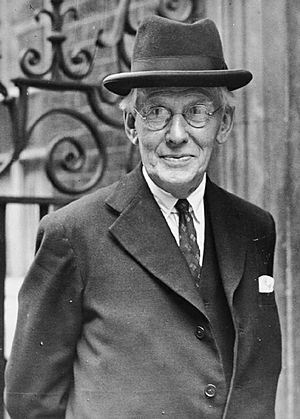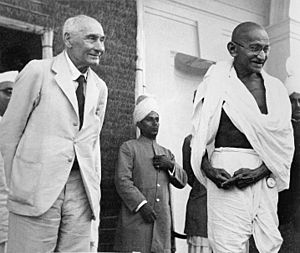Frederick Pethick-Lawrence, 1st Baron Pethick-Lawrence facts for kids
Quick facts for kids
The Lord Pethick-Lawrence
|
|
|---|---|

Lord Pethick-Lawrence at 10 Downing Street
|
|
| Leader of the Opposition | |
| In office 21 January 1942 – February 1942 |
|
| Monarch | George VI |
| Prime Minister | Winston Churchill |
| Preceded by | Hastings Lees-Smith |
| Succeeded by | Arthur Greenwood |
| Financial Secretary to the Treasury | |
| In office 11 June 1929 – 24 August 1931 |
|
| Monarch | George V |
| Prime Minister | Ramsay MacDonald |
| Preceded by | Arthur Samuel |
| Succeeded by | Walter Elliot |
| Secretary of State for India and Burma | |
| In office 3 August 1945 – 1947 |
|
| Monarch | George VI |
| Prime Minister | Clement Attlee |
| Preceded by | Leo Amery |
| Succeeded by | The Earl of Listowel |
| Personal details | |
| Born |
Frederick William Lawrence
28 December 1871 London, England |
| Died | 10 September 1961 (aged 89) Hendon, London, England |
| Political party | Labour |
| Spouses | |
| Alma mater | Trinity College, Cambridge |
Frederick William Pethick-Lawrence, 1st Baron Pethick-Lawrence (born Frederick William Lawrence; 28 December 1871 – 10 September 1961) was an important British Labour Party politician. He is well-known for his work supporting women's right to vote. He was also a member of the Privy Council, a group of advisors to the King or Queen.
Early Life and Education
Frederick William Lawrence was born in London, England, on 28 December 1871. His family was quite wealthy and belonged to the Unitarian faith, which is a type of Christian belief. His family was also involved in politics. Three of his father's brothers, William, James, and Edwin, held important political roles. These included serving as Lord Mayor of London and as members of parliament.
Frederick went to Wixenford and Eton, which are famous schools. He then studied at Trinity College, Cambridge. While at Cambridge, he was part of the Cambridge University Liberal Club. After finishing his studies, he became a barrister, which is a type of lawyer who argues cases in court.
Political Journey

Frederick met Emmeline Pethick, who was a strong supporter of socialism and a campaigner for women's voting rights. They fell in love and married in 1901 after Frederick also became a socialist. They decided to combine their surnames, becoming 'Pethick-Lawrence'.
Frederick helped publish newspapers that supported left-wing ideas, including Votes for Women. He became very involved with the Labour Party. He strongly supported women's right to vote. His work with the Women's Social and Political Union (WSPU) led to him being imprisoned for nine months in 1912. This happened after some WSPU members broke windows as part of their protests. Even though Frederick disagreed with these specific actions, he faced consequences for his activism. Because of this disagreement, he was even asked to leave the WSPU by Emmeline Pankhurst and Christabel Pankhurst.
During the early part of the First World War, Pethick-Lawrence helped start the Union of Democratic Control (UDC). This was a major organization that was against the war. He became the Treasurer for this group. In 1918, he was recognized as a conscientious objector, meaning he refused to fight in the war because of his personal beliefs. Instead of fighting, he worked on a farm in Sussex.
In 1923, Pethick-Lawrence was elected as a Member of Parliament (MP) for Leicester West. He served as the Financial Secretary to the Treasury from 1929 until 1931. After the Labour Party lost many seats in the 1931 election, he also lost his own seat.
He was elected again as an MP for Edinburgh East in 1935. In 1937, he became a member of the Privy Council. For a short time in early 1942, he served as the Leader of the Opposition.
In 1945, Pethick-Lawrence was given the title of Baron Pethick-Lawrence, which made him a member of the House of Lords. From 1945 to 1947, he was the Secretary of State for India and Burma. This was a very important role, and he was part of the cabinet. He played a part in the discussions that led to India gaining its independence in 1947. However, it was Prime Minister Clement Attlee who made the main decisions about India during this time.
Later Life
His first wife, Emmeline, Lady Pethick-Lawrence, passed away in 1954. Lord Pethick-Lawrence later married Helen Millar Craggs in 1957. He died in Hendon, London, in September 1961, when he was 89 years old.
His older sister, Annie Jane Lawrence (1863-1953), was known for building an open-air school called The Cloisters in Letchworth Garden City. This school was designed in the Arts and Crafts style.
Legacy
Frederick William Pethick-Lawrence is remembered for his contributions to British politics and his strong support for women's rights. His name and picture are featured on the plinth (the base) of the statue of Millicent Fawcett in Parliament Square, London. This statue, unveiled in 2018, honors important supporters of women's suffrage.

